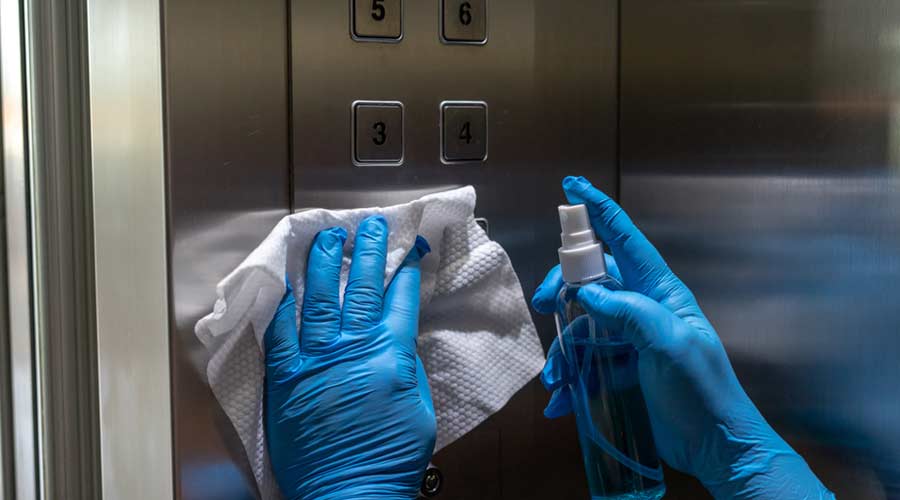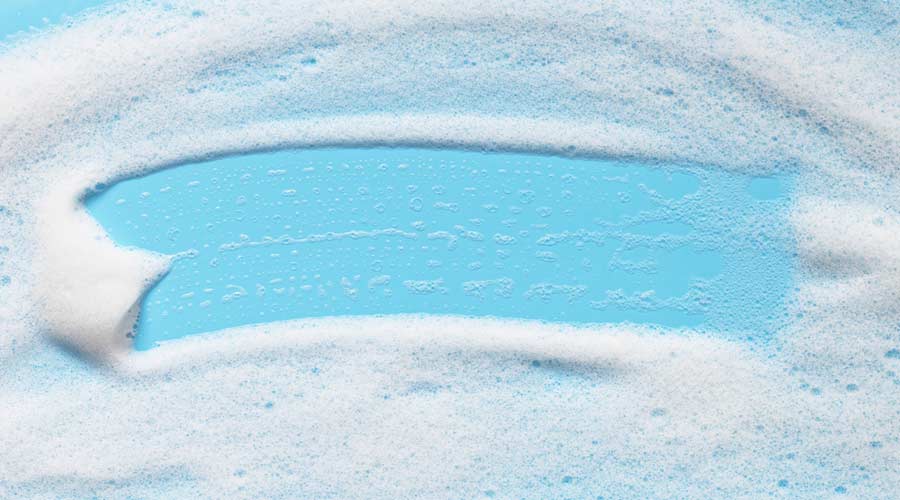The main use of scrubbers — the workhorses of the housekeeping profession — is cleaning and stripping floors, but the machines are so versatile that they also can clean carpet, wood and marble floors. Most facilities have at least one scrubber, which tends to last for years, since it is one of the best-built pieces of machinery in the cleaning industry. Most models can withstand years of abuse with little maintenance.
Nonetheless, every piece of floor-cleaning equipment requires replacement eventually. The task of selecting the most appropriate scrubber for a particular facility’s needs centers on the specifier’s understanding of a scrubbers’ features and functions and, more importantly, how these pieces of equipment help housekeeping crews meet facility cleaning needs.
Scrubber types
Housekeeping managers have access to several types of scrubbers offering a range of features and functions:
- Slow-speed scrubber. This old standby — a 175-rpm, side-by-side floor machine — can strip and scrub floors and bonnet-clean carpet. If it is equipped with a tank, cleaning crews can use the machine for rotary-foam shampooing, as well as for polishing marble and terrazzo. Some facilities still use this scrubber to spray-buff floors.
- Autoscrubber. This type of scrubber is usually battery operated, though it can be cord-electric, and a propane version is scheduled to come out soon. This machine puts down a cleaning solution, then scrubs it with a pad or brush and picks up the dirty solution. Autoscrubbers range in size from 17 inches up to more than 40 inches, and some of these units have a riding option. Many large units have controllable pad pressure, which can equal the pressure of that of a 175-rpm, slow-speed unit and that cleaning crews can use to strip floors. An autoscrubber is a must for cleaning crews that spend a great deal of time mopping floors.
- High-speed buffer. The sole purpose of this type of buffer, which runs up to 1,500 rpm, is to produce a shiny floor. Any manager who wants a shiny floor and doesn’t have a great deal of tile should consider purchasing this type of machine.
- Ultra-high-speed buffer. This cord-electric buffer runs at more than 1,500 rpm and should be used in conjunction with an ultra-high-speed finish. Its high rpm can cause a non-ultra-high-sheen finish to powder or swirl, but this scrubber is much more efficient and faster than a regular high-speed burnisher.
- Autoburnisher. Models of this battery-powered burnisher vary in size, from 20 inches to more than 40 inches, and they usually operate at 2,000 rpm. The unit is a must-have for facilities with a large amount of tiled areas that require burnishing.
- Propane stripper. Due to their speed, weight and lack of electric cord, propane-powered strippers offer a very effective unit for any operation that has massive amounts of tile to strip. It is a favorite of contractors with large retail accounts.
- Propane buffer. A propane-powered burnisher operates at about 3,000 rpm, and, because of its weight, tends to deliver the best results of any type of burnisher. This machine should be the first choice for those managers with facilities that contain a large amount of tile if the use of propane is approved.
With all of these equipment options, which ones best meet facility needs?
Most every type of facility needs a 175-rpm floor scrubber because the machine is versatile and still one of the best machines on the market for stripping floors. And any facility that expends a great deal of labor mopping floors needs an autoscrubber.
Also, either a propane-powered buffer or an autoburnisher can provide labor savings in facilities that have a large amount of tile that requires burnishing.
A bottom-line view
How does a facility decide what housekeeping equipment they should invest in?
All equipment can save time, but finding the most efficient and cost-effective option takes a little bit of math. A cost analysis can help managers determine the most appropriate scrubber for a particular facility.
The first step in the analysis is to find the amount of time the facility spends on such tasks as mopping, spray-buffing and burnishing with cord-electric equipment. Then, take that figure and multiply it by the hourly wage paid to workers. The result is the total amount of labor cost that is used to perform a task.
Take mopping, for example. Four employees mop a facility’s four 1,000-foot hallways, and each hallway takes about 30 minutes for a total of two hours a day. The total mopping time is 10 hours a week, 40 hours a month, or 480 hours a year.
If each employee earns $8 per hour, then 480 hours multiplied by $8 per hour equals $3,840 per year in labor to mop the floor.
Mopping by hand takes one-half hour per 1,000 square feet. Using a 20-inch autoscrubber, a worker can clean the same hall in seven minutes. The same task that took two hours per night now takes about 30 minutes per night.
If all the floors are in the same building, one autoscrubber is needed. Mopping takes 480 hours per year; auto scrubbing takes 112 hours per year. That is a time savings of 360 hours per year or $2,944 per year labor cost at $8 per hour.
The cost of a new autoscrubber is about $3,000. With the labor savings, a manager can pay for a new machine in one year, not including the labor saved from less frequent stripping and waxing.
As the pad size increases, so does productivity, as well as the cost of the machine. The more square feet of tile in a facility, the larger the machine managers would want to crews to use.
Using an autoscrubber instead of mopping by hand also will help the floors. An autoscrubber does a better job cleaning and picks up dirty water. This feature will extend the life of the floor finish by reducing stripping and waxing, which is a huge cost-savings.
Burnishing issues
In making a decision on buying a burnisher, it is important for managers to determine how much time is spent burnishing with a cord electric burnisher. In making the decision to move up to either a propane- or battery-powered burnisher, managers must realize that a facility will need a fair amount of tile to recoup the equipment cost.
If this move is cost effective, one also can increase the frequency of burnishing, which will make the floors look better longer and keep that wet look for which most facilities strive.
As with any kind of transition, negative factors exist in going from cord-electric equipment to battery powered. Battery power gives the operator greater freedom and speed, but most battery-powered units only last about 4.5 hours, depending on both the size and number of batteries per unit.
Some burnishers last up to seven hours. Also, battery-operated scrubbers and buffers can cost twice as much as cord-electric units.
George Weise is zone manager housing at the University of South Carolina.
|
|
| Managers can take a big step toward finding the right scrubber by doing a cost analysis using, among other factors, cleaning and equipment guidelines such as these from the International Sanitary Supply Association. All times are based on 1,000 square feet: Autoscrubbers • 17-inch — 9 minutes • 24-inch — 6 minutes • 32-inch — 4.2 minutes. • 28-inch riding scrubber — 2.19 minutes. Dry burnishers • 175 rpm 17-inch — 30 minutes • 350 rpm 17-inch — 19.8 minutes • 1,000 rpm 17-inch — 7.2 minutes • 1,000 rpm 20-inch — 6.6 minutes • 2,000 rpm 20-inch — 6 minutes • 2,000 rpm 27-inch — 4.2 minutes • 17-inch propane — 4.3 minutes • 20-inch propane — 3.65 minutes • 24-inch propane — 3.05 minutes. Spray buffers • 175 rpm 17-inch — 34.8 minutes • 350 rpm 17-inch — 25.2 minutes. — George Weise |
|
|
| The process of specifying a quality scrubber starts with understanding the essential facts about the equipment. Most floor scrubbers range in size from 13 inches to 22 inches, have a 1.5 horsepower (hp) motor at 175 rpm, and weigh about 100 pounds. Standard features often include: a 50-foot, 600-volt electric cable; non-marking wheels; and a solid surface of heavy-duty steel/aluminum or plastic housing. At one time, a slow-speed scrubber could do it all — scrub, strip, buff and polish. While these scrubbers remain key tools in floor care, now they are just one of the many tools housekeeping crews use. Managers now have access to many different types of scrubbers and buffers designed to make floor care more productive and cost efficient. Over the last 30 years, floor finishes have changed a great deal, and that has caused floor-care-equipment manufacturers to make improvements to keep up with the finishes and chemicals. Floors that used to take hours to clean and polish can now be done in a fraction of the time with modern equipment. In the 1960s, a cleaner buffed the wax with a slow-speed scrubber and horsehair brush to remove the scuffs left in its soft finish. In the 1980s, it was not uncommon to clean the floor and then spray-buff with a 175- or 300-rpm scrubber. This process produced good results but took hours to complete. Now, cleaning crews can use a cleaner or restorer in a battery-powered autoscrubber to clean a floor and leave a film that is buffed with a high-speed buffer. If a cleaner uses either a propane buffer or battery burnisher, he or she can buff at walking speed. Using an automated scrubber and autoburnisher, two people in one hour can clean and burnish more than 10,000 square feet per hour — a process that used to take days to complete. — George Weise |

 The Down and Dirty on Cleaning in Virus Season
The Down and Dirty on Cleaning in Virus Season How Surfactant Use is Expanding in Commercial Cleaning
How Surfactant Use is Expanding in Commercial Cleaning